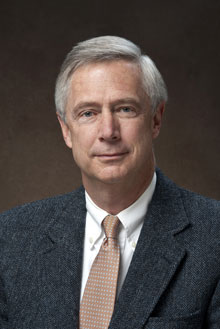You have /5 articles left.
Sign up for a free account or log in.
In an effort to make sure it won’t overspend when times are good or starve itself of money when times are bad, the University of the South decided last month to change how it spends its $350 million endowment.
The Tennessee liberal arts college, also known as Sewanee, joins a small minority of American colleges that use inflation adjustments to determine how much money to draw each year from their endowments. This, Sewanee's leader said, will allow the university to plan for the future in ways it hadn't been able to.
Typically, endowment fund managers look at the size of their endowment to determine how much they should spend. About 77 percent of American colleges look at average size of the endowment over about 12 financial quarters and spend a fixed rate – usually 5 percent.
Sewanee Vice-Chancellor John McCardell joins of a group of colleges that have become convinced the usual method is not ideal.
“I’m even more convinced that what that approach does is give you more money than you need to spend or ought to be spending in good times; and less money than you need to spend or ought to be spending in bad times,” he said. “Which seems to be the exact opposite, it seems to me, of where you want to be or ought to be.”
McCardell’s point is that when markets have been bad, typical endowment spending policies cause colleges to respond by taking less money from their endowment because they are committed to drawing 5 percent of the average size of an endowment, regardless of what the endowment’s size has been.
“There’s nothing magical about 5 percent,” McCardell said, adding it could end up being “unnecessarily severe.”
This means when times are tough and colleges might want to turn to their endowment to help prop up the operating budget, they end up getting less money. But when markets have been bullish, colleges tend to spend at times when they may need that money the least.
“The idea is that this smoothes out volatility, when really it does not,” McCardell said.
So Sewanee’s board recently joined about 5 percent of American colleges that use a different approach, which takes the previous year’s spending and then adds inflation. This means colleges take a certain amount of money almost regardless of market performance. Colleges do acknowledge market performance slightly, by putting a ceiling on the spending (of 5.5 percent of the endowment’s value at Sewanee) to make sure they don’t deplete the endowment and a floor on the spending (4.5 percent at Sewanee) to make sure they aren’t failing to acknowledge strong market growth.
In the upcoming fiscal year, Sewanee plans to take $13.6 million from its endowment toward its $80.4 million operating budget. In coming years, the number will go up with inflation – either the Consumer Price Index, the Higher Education Price Index or some other custom measure the university decides on.
This way, Sewanee can more predictably count on how much money it will be taking from the endowment. Sewanee looked back and found that if it had used an inflation-adjusted spending plan over the past five years, the size of its endowment would be almost exactly the same but the university would not have had to deal with market swings that meant it was cutting its operating budget when it could least afford to.
McCardell said one of the assumptions of the plan is that the market won’t tank while inflation is rising. Another assumption is that endowment growth will meet or exceed inflation.
Bill Jarvis, the managing director of the Commonfund Institute, which advises nonprofit investors and helped prepare the report, said he’s surprised more colleges have not adopted inflation-adjusted spending plans. Already, he said, many institutions that use endowment funding for a significant chunk of their operating budget use similar methods.
Yale University and Stanford University, for instance, have an endowment spending method that relies on a combination of inflation and average endowment size.
About 7 percent of endowments use that hybrid method, according to the latest study of endowment trends by the Commonfund and the National Association of College and University Business Officers. Most of them are colleges with endowments larger than $100 million.
Jarvis said presidents at institutions that don’t rely exclusively on market returns have to exercise willpower: When everyone else is bragging about being able to spend a lot during a strong market, those presidents can’t, and when other institutions are cutting spending, those presidents have to keep spending level.
McCardell said he is now able to plan five years into the future because he can more easily predict what will be coming from his endowment, which makes up around 16 percent of Sewanee’s operating budget.
“This is a decision that at least in the next little bit will allow us to spend a bit more and invest a bit more in our students and our faculty and our physical plant,” he said.








